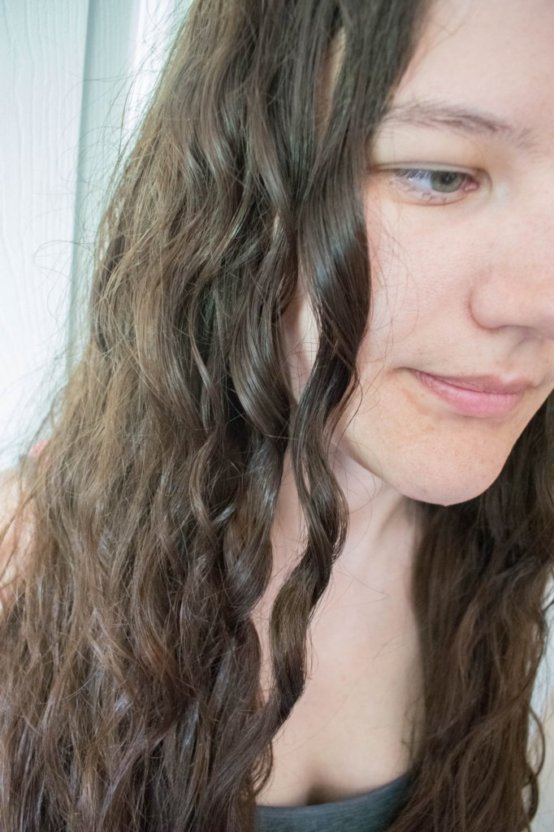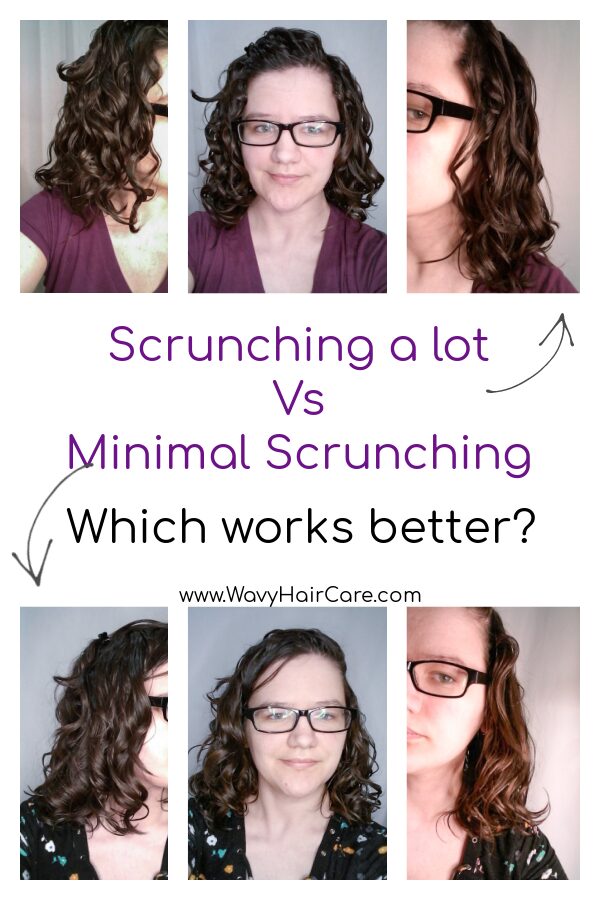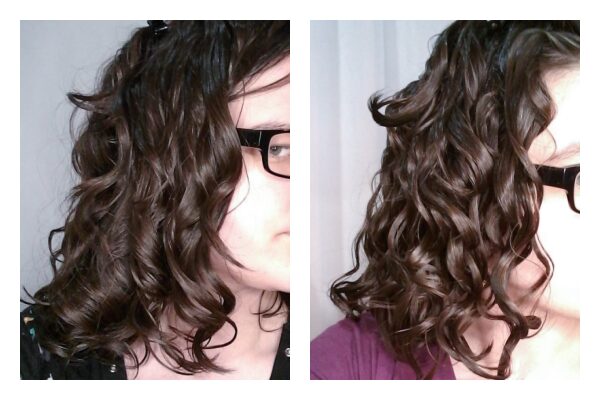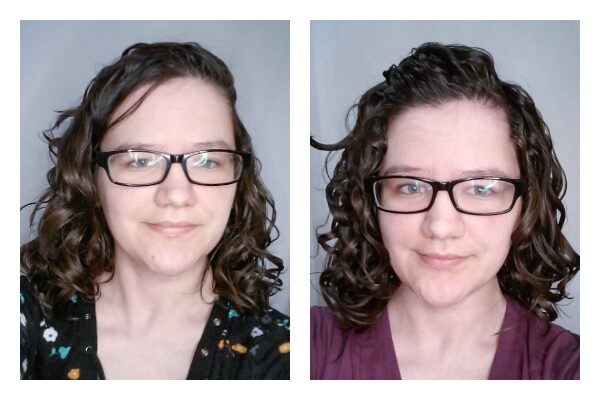Early on when attempting the curly girl method, I felt like scrunching my hair much at all would make my hair more frizzy, and would break up my curl clumps quite a bit.
At the same time, I did recognize that scrunching my hair right at the end of my shower helped my hair to separate from one big blob into clumps. I also recognized that if I walked around after my shower for quite a while, my roots would start to fall flat, and that scrunching again could help revive some waves to the top of my strands.
For about 2.5 years, my goal was to scrunch enough to form clumps but not so much as to cause my clumps to break up or get frizz.
I would just scrunch a couple of times at the very end of my shower, scrunch each section of my hair once after applying my mousse, and then if my roots were really falling flat before I was done diffusing, I’d sometimes scrunch with a shirt (aka microplop – click for my microplopping tutorial) an additional time to avoid those flat/straight roots.
I still don’t think that was a bad technique. It worked. I’ve learned a few things, and realized a couple things about my own hair, in the last couple of months that have changed my technique. I now scrunch a lot more than I used to. I’ll get to why later.
I did one wash day where I did a little scrunching, and one wash day where I did a lot of scrunching, so I could compare for you all. Let me get a bit more into the details first though!

Are scrunching and squish to condish the same thing?
Scrunching and squish to condish are not exactly the same thing. Scrunching is any time that you grasp your hair in your hand and squeeze. Meaning it could be done on wet, damp or dry hair. Squish to condish is squeezing your hair in your hand while you have cupped water in your hand.
If you look up squish to condish tutorials on YouTube, you’ll see people in the shower, cupping their hand to collect water, and then taking that cupped hand to grasp a section of hair and scrunch it. This is true squish to condish.
I personally also consider it ‘squish to condish’ if I scrunch my hair while it’s absolutely soaking wet. I find it extremely tedious to continuously cup water into my hair. More tedious than what I am willing to do, frankly.
My lower-effort version of squish to condish while in the shower is to pop my head under the showerhead for a second or two, to get it soaking wet. Then I step out of the showerhead and squish while my hair is soaking wet, until it starts to lose some water. Then I step back under the showerhead for a second or two to soak it again, squish some more, etc.
Why squish to condish?
The purpose of squish to condish while in the shower is to spread out your conditioner, and to get water and conditioner into your hair strands.
I read this article from “the science-y hair blog” titled: Conditioning technique: Squish To Condish, how it works. It helped me to understand how/why squish to condish is a more effective way of conditioning hair. I highly recommend reading the article.
In a nutshell though, it explains how traditional washing/conditioning methods don’t get hair strands evenly saturated, and don’t get hair strands evenly coated in conditioner, either. It explains (And shows) how squish to condish helps get water and conditioner over ALL of your hair, for a more successful conditioning.
How long should I scrunch wavy hair?
If you want the biggest clumps possible, minimal scrunching is best. If you want more consistent waves, better definition, or to better distribute your hair products, scrunch for a couple of minutes. Make sure your hair is wet and/or conditioned as you scrunch to avoid creating frizz.
I have found that scrunching for a few minutes after adding my products gives me a better cast, and more consistent waves. However, it does produce skinnier curl clumps. Meaning, if curl clumps are the most important aspect to you, scrunching less may be the better option for you.
Scrunching at the right part of your routine can make a big difference! Scrunching at the end of the shower without products in your hair may cause your clumps to break up badly and introduce a lot of frizz. Scrunching more after you’ve added products will do less ‘damage’ to your curl clumps.
I have been scrunching longer (a couple of minutes, vs maybe 10 squishes total in the past) for a few weeks. I just tried it once, and felt it was giving me better results so I continued. However, for the sake of this blog post, I wanted to try out minimal scrunching, and then scrunching for a long time, so I could directly compare. Also, so I could share with you guys!

Comparing results from minimal scrunching vs scrunching a lot
To attempt to control other variables, I did my best to do the same routine, including the same products and the same techniques, on two different wash days. Except one wash day, I scrunched a lot, and the other I scrunched minimally.
If you’re curious, the base of my routine on both days was as follows: Keep my head upside down for most of my shower. Shampoo just my scalp with about 1 quarter worth of Not Your Mother’s Curl Talk Shampoo. Rinse out. Condition my hair from a couple inches past my roots on down to the end with Johnsons Kids Strengthening Conditioner.
I used about a half-dollar-sized amount of conditioner. Clip my hair and let the conditioner soak for a couple of minutes before rinsing it out. Rinse the conditioner out. Use fingers to pull hair off the back of my head, tilt head from side to side to keep it from being a mess in the back. Plop hair for 10 minutes.
Remove plop and add 3 handfuls of Aussie Instant Freeze Mousse using glazing then scrunch technique. Pixie diffuse all of my hair upside down for 5 minutes. Flip upright and diffuse my hair in quarter sections (front left, front right, back right, back left) until 90% dry. Stay in the cast for a couple of hours until I know it is 100% dry, then scrunch out the crunch.
What I did differently was:
On the “Scrunch a lot” day, I did squish to condish while I had shampoo in my hair for about 30 seconds. I did squish to condish for about 2 minutes while I had conditioner in my hair. At the end of my shower (after removing hair from the back of my head and tilting side to side) I scrunched for about 1 minute. After plopping and adding mousse, I squished for about 3 minutes.
On the “scrunch minimally” day, I did not squish to condish with shampoo. I did squish to condish for about 30 seconds with the conditioner. Then at the end of my shower, after I had removed the hair from the back of my head and tilted side to side, I scrunched each section of my hair while upside down.
I did about 4 scrunches to reach all sections, then I tilted left and scrunched the back a couple of times, then tilted right and scrunched the back side a couple of times. So roughly 10 total scrunched at the end of my shower. While I didn’t scrunch very long at that phase, I did scrunch pretty hard because I was trying to get water out of my hair at that step.
I knew if I scrunched lightly, that would leave a lot more water on my hair than usual which would potentially result in my results looking more weighed down just due to water weight, which I didn’t want to happen. Then after I added mousse, I just scrunched each section of hair one time to help it pop back up (about 4-5 total scrunches).
Note: On the ‘scrunch a lot’ day, I intentionally didn’t scrunch a ton after my shower. I knew from past experience that excessive scrunching after my shower will dramatically separate my curl clumps, basically making my hair not have any clumps at all.
I also knew scrunching a lot at that phase can introduce frizz. I also knew from past experience that scrunching a bit later, after I have added mousse, doesn’t seem to have the same impact. That’s why I did most of my scrunching after adding mousse.

Scrunched minimally on the left, scrunched a lot on the right.
The results:
On the day that I scrunched a lot, my clumps weren’t super thick, but they weren’t super stringy, either. I noticed that my clumps broke up the most when I was scrunching right after my shower. When I scrunched with mousse in my hair, I only saw my clumps break up a tiny bit.
I had some frizz, but it wasn’t excessive. I had a really good, strong cast. I had good definition, my waves started a bit higher on my head, and I had a slightly tighter curl pattern.
On the day that I did minimal scrunching, I only had a cast from about my ears on down, which resulted in my hair not being very wavy higher up on my head. Only the very ends of my hair had a hard cast, the midsection of my strands had a soft to medium cast.
I used the same amount of mousse, and applied it the same way on both days. I think the frizz was roughly the same on both days, though slightly worse on the ‘minimal scrunch’ day – which surprised me!

Photo on left was minimal scrunching, photo on right was scrunching longer.
My conclusion:
I see a big difference in my cast, when I squish longer. My waves seem to have better definition, are slightly tighter, and last longer. I believe the reason why my waves hold longer is due to getting a better cast from better mousse distribution.
Similar to the way that squish to condish helps get conditioner better distributed across all of your hair strands evenly, I believe that squishing your hair longer after adding products may help distribute product evenly. It also seemed to make my curl pattern a bit tighter and more consistent.
I think how wet your hair is when you squish is really important. It’s really important to note that although I plopped for 10 minutes before adding product and doing additional squishing, my hair is still wet enough that I hear a ‘squish’ sound when I squeeze my hair after adding product.
My hair holds on to a lot of water, so others who tried to plop for 10 minutes before adding products and scrunching would likely have dryer hair that may not get similar results. I think you want your hair to be wet enough to still squish when you squeeze.
I think squishing for a long time when your hair is too dry would make it break up your clumps a lot more and may introduce a lot more frizz. I sometimes see people try to squish or microplop the whole time their hair dries, and I think that would be a disaster on my hair, at least.

Scrunching minimally on the left, scrunching a lot on the right.
From the other views, I definitely prefer the ‘scrunched a lot’ results. On this straightforward view, I prefer the volume from the ‘scrunched a lot’ side, but I do like that big fat clump on the left side on the ‘scrunched a little’ side!
How to scrunch wavy hair without frizz
The biggest key to scrunching your hair without frizz is making sure your hair is wet enough and/or conditioned enough.
While mousse isn’t something I typically see as conditioning, it is wet and slippery to some degree, so I believe that’s why I’m able to scrunch my hair after adding mousse and not get a ton of frizz. To a lesser degree, being gentle with your hair when you squish (doing so mindfully, not pushing your fingers through the middle of clumps when squishing, etc.) may help some.
I believe that how well moisturized your hair is in general may be a big factor. Meaning, whether your hair is generally dry or whether it’s generally well moisturized, not just in the moment as you squish.
I’ve been following the curly girl method about 3 years now, and my hair is not damaged, doesn’t struggle to stay moisturized. It seems common for people with damaged hair, and/or people who are new to the curly girl method, to struggle more with frizz in general, but also with getting stringy, frizzy hair as a result of frizz.
If you’re struggling with this, I’d recommend wet styling, meaning adding your products right after you’re done in the shower. This will help your clumps stay intact and more moisturized.
When I was newer the curly girl method, my hair was more dry and damaged, and wet styling worked better. Now I prefer damp styling, because my hair stays more moisturized. Early on, I thought I could only do minimal scrunching, but I think I could have scrunched more as long as I made sure that my hair stayed really wet while I scrunched.
Looking to learn more about wavy hair care techniques? Here are a few other technique-related blog posts of mine:
Thank you for the tip. I will try it next time I wash my hair. I seem to suffer from not a lot of wave in my hair. I hope this tip works for me